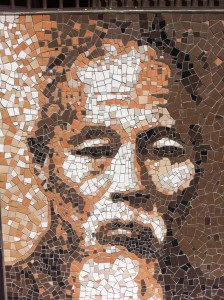
Seo Sang Don mural near Gyesan Cathedral and his house.
My wife and I spent a day in Daegu (대구), Korea retracing the steps and imprint of her great great-grandfather, one Seo Sang Don (1850-1913). Seo Sang Don (서상돈) was a born into a Catholic family of martyrs and started fairly destitute (as a result, I am guessing, of his family’s Catholic persuasion- generally frowned upon at that time, hence the martyrs), but managed to become a wealthy businessman specializing in textiles and paper production.
The family itself has a long history of introducing Catholicism to Korea. Seo Sang Don’s great great-grandfather Seo Gwang Soo entered the Catholic Church in 1784 with his five sons (which is right at the very beginning of Catholicism’s entry into Korea). In March of 1785, he was expelled from his Seo clan because of this conversion to Catholicism (and presumably had his wealth and title stripped of him) and the family was more or less torn apart.
It was into this environment that Seo Sang Don was born on October 17, 1850. His father passed away when he was 9 years old and Seo Sang Don lived with his maternal grandfather in Daegu (specifically in the Saebanggol neighborhood). He started work very young, initially as an errand boy at a store and, after he turned 18, as a peddler with help from members of the local Catholic community. He worked hard and prospered and by the time he was 35, he was a leading economic light in Daegu. He was wealthy enough to harvest 30 thousand bags of rice each year, a staggering sum for the time.
Soon thereafter, there was another wave of Catholic persecution and Seo devoted himself to thrift, missionary work, and volunteer activities; he also saw his uncles (Seo In Soon, Seo Ik Soon, and Seo Tae Soon) martyred for their beliefs. Eventually, a Father Robert (Kim Bo Rok) moved to the area and Seo Sang Don donated his land and contributed vast sums of money to first build a temporary church and then to build Gyesan Cathedral (as seen below) in 1897. Seo Sang Don also secured the bishop’s seat in Daegu.
With seemingly boundless energy, Seo Sang Don established a Chinese reading school, Haesongjae, and then rechristened it Seonglip School in 1908. He also created a Seonglip School for girls in 1910 (a very progressive move for the time), after having established another girl’s school in 1905. In 1906, he organized Daegugwangmunsa in order to publish textbooks, magazines, newspapers (which roused the suspicions of the soon to be colonial masters, the Japanese). This suspicion was partially based on the fact that Seo Sang Don was very active in the Independence Club of Daegu.
In 1906, a few years before the official annexation of Korea into the Japanese Empire (1910), Korea’s debt to Japan was crushing and Seo Sang Don vowed to reduce this economic yoke. He did so by creating the National Debt Repayment Movement (국채보상운동기념공원). The Movement represented an amazingly active grassroots movement to pay down the national debt, with rich and poor alike contributing what they could. This spread into mass movements across the nation where Koreans would donate the money they would normally use to buy cigarettes for the cause. Seo Sang Don hosted mass meetings of the public, some of the first opportunities to witness the changing social dynamics of the incredibly hierarchical Korean nation. Rich, poor, male, female, the King himself, Korean residents abroad, etc, all working together towards debt repayment. All of this spearheaded by my wife’s great great-grandfather, Seo Sang Don.
The movement ultimately failed due to a host of reasons, but not before it united the country in one last defiance of colonization before it was officially absorbed into the Japanese Empire in 1910. Seo Sang Don died on June 30, 1913 surrounded by his family at his home in Daegu (as seen below). This home is a landmark in Daegu and it is a short three minute walk to Gyesan Cathedral from there.
So, my wife comes full circle on a family journey. Wonderful story. To see the full photoset from the day, click here.



[…] went there to research my wife’s family history. We saw his house, his land, his imprint on the city. We went back to the station and waited for […]
[…] My wife’s great great grandfather, he inspired me. […]